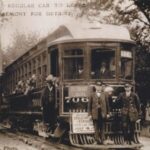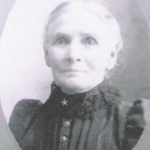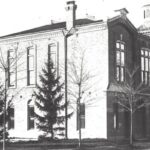William Allen, George Washington Allen, James Thorington, and Levi Washburn cut the road from Washington (about 30-Mile road) to downtown Almont in 1827. As they worked their way northward, they experienced many a restless, if not sleepless, night because of the howling of nearby wolves. They also occasionally encountered bears on their trek to Almont. The early settlers of Almont also had to deal with the presence of bears and wolves. While preparing a meal, Catherine Sleeper had a wolf put its paws up on the window opening (before windows were installed) of her log cabin, which was located just south of the Clinton River (south of “King’s Mill” – 702 South Main Street).
Oliver Bristol (probably in 1832) had a life threatening encounter with a bear near the site of the present First Congregational Church.
Though I have seen no written records, it is probable that the earliest settlers conducted hunts specifically to eliminate the threats posed by the wolves and bears. Even into the early 1840’s there were reports of settlers still hearing the occasional howl of a wolf.
Squirrels did not pose the threat of bodily harm but were an expensive nuisance. Seeking warmth and shelter, they chewed their way in homes causing water and ventilation damage to the homes. More serious was the gnawing into the grain storage areas and eating seeds and crops. The damage to the crops was not just the portion that the squirrels ate but the portion of the crop that they contaminated. Water damage to the crops was also a serious problem.
In 1843, as a part of the second community celebration of the Fourth of July, a squirrel hunt was organized. It was set up as a competition between the northern section of the township against the southern section. The precise location of the dividing line between the two sections is not known. However, based on the distribution of the township’s population, it was probably St. Clair St. The hunt was to take place during the week before July 4th.
The prize for those who participated was a luncheon, which was put on with contributions from the local farmers. To get a seat at this festival table, men had to bring in 50 squirrel tails and boys needed 25. Almost everyone who chose to join in the hunt was able to secure the necessary number of squirrel tails. The southern section won. A total of 5,700 tails were submitted. Obviously, there were a tremendous number of squirrels in the township.
It must have been an incredibly noisy week. Assuming the hunters only hunted for 14 hours a day, to get to 5,700 tails would require one squirrel to be shot every minute!! Of course, many of the squirrels could have been (and probably were) trapped instead of shot. Following the luncheon was a parade with the marshals being William Myers and John Colwell. Later on there was a dinner with toasts and speeches.




